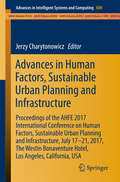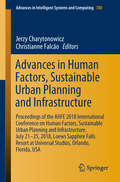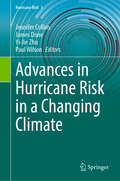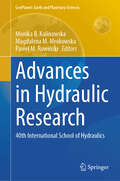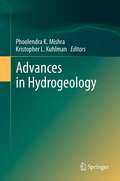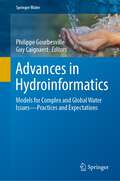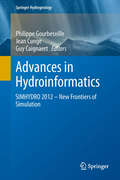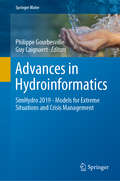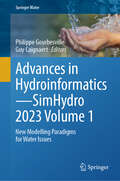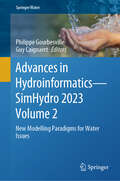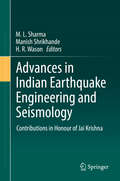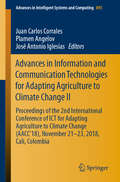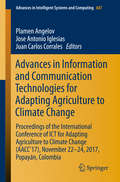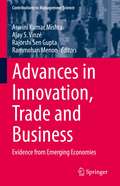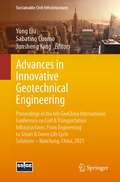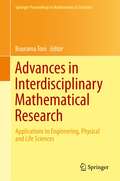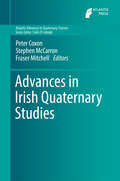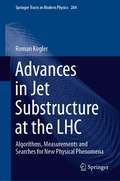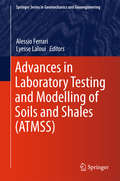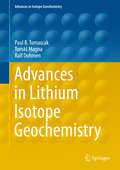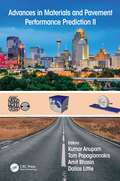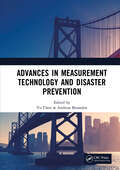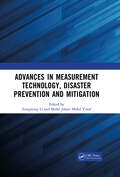- Table View
- List View
Advances in Human Factors, Sustainable Urban Planning and Infrastructure: Proceedings of the AHFE 2017 International Conference on Human Factors, Sustainable Urban Planning and Infrastructure, July 17−21, 2017, The Westin Bonaventure Hotel, Los Angeles, California, USA (Advances in Intelligent Systems and Computing #600)
by Jerzy CharytonowiczThis book deals with human factors research directed towards realizing and assessing sustainability in the built environment. It reports on advanced engineering methods for sustainable infrastructure design, as well as on assessments of the efficient methods and the social, environmental, and economic impact of various designs and projects. The book covers a range of topics, including the use of recycled materials in architecture, ergonomics in buildings and public design, sustainable design for smart cities, design for the aging population, industrial design, human scale in architecture, and many more. Based on the AHFE 2017 International Conference on Human Factors, Sustainable Urban Planning and Infrastructure, held on July 17-21, 2017, in Los Angeles, California, USA, this book, by showing different perspectives on sustainability and ergonomics, represents a useful source of information for designers in general, urban engineers, architects, infrastructure professionals, practitioners, public infrastructure owners, policy makers, government engineers and planners, as well as operations managers, and academics active in applied research.
Advances in Human Factors, Sustainable Urban Planning and Infrastructure: Proceedings of the AHFE 2018 International Conference on Human Factors, Sustainable Urban Planning and Infrastructure, July 21-25, 2018, Loews Sapphire Falls Resort at Universal Studios, Orlando, Florida, USA (Advances in Intelligent Systems and Computing #788)
by Jerzy Charytonowicz Christianne FalcãoThis book discusses human factors research directed towards realizing and assessing sustainability in the built environment. It reports on advanced engineering methods for sustainable infrastructure design, as well as on assessments of the efficient methods and the social, environmental, and economic impact of various designs and projects. The book covers a range of topics, including the use of recycled materials in architecture, ergonomics in buildings and public design, sustainable design for smart cities, design for the aging population, industrial design, human scale in architecture, and many more. Based on the AHFE 2018 International Conference on Human Factors, Sustainable Urban Planning and Infrastructure, held on July 21–25, 2018, in Orlando, Florida, USA, it offers various perspectives on sustainability and ergonomics. As such, it is a valuable reference resource for designers, urban engineers, architects, infrastructure professionals, public infrastructure owners, policy makers, government engineers and planners, as well as operations managers and academics active in urban and infrastructure research.
Advances in Hurricane Risk in a Changing Climate (Hurricane Risk #3)
by Paul Wilson Jennifer Collins James Done Yi-Jie ZhuTropical cyclones (including hurricanes) are becoming more destructive. Rising seas are resulting in greater storm surge inundation. More moisture-laden, warmer air is leading to heavier rains. There is also mounting evidence for more powerful winds and a greater incidence of the strongest storms. Do we fully understand these changes, and what will these changes mean for society? Arising from the 2024 Symposium on Hurricane Risk in a Changing Climate, this book contains new research on hurricane behavior, our vulnerability, and how we communicate the risk. This book is essential reading to understand the future of tropical cyclone risk and what it means for society.
Advances in Hydraulic Research: 40th International School of Hydraulics (GeoPlanet: Earth and Planetary Sciences)
by Paweł M. Rowiński Monika B. Kalinowska Magdalena M. MrokowskaThis book provides an overview of advances in experimental, numerical modelling, and theoretical aspects of environmental hydraulics. By highlighting the latest findings on processes in natural aquatic systems, solutions for civil engineering and water resources management, with a special focus on interdisciplinary cooperation between Earth scientists, ecologists, biologists and hydraulic engineers that have helped to mitigate the impacts of anthropopressure on river habitats, it provides both researchers and practitioners with first-hand information about the latest trends in hydraulic research. The book combines peer-reviewed versions of invited lectures and regular presentations at the 40th International School of Hydraulics, held May 23–26, 2023, in Kąty Rybackie, Poland. With contributions from world-leading experts and young researchers, many areas of environmental hydraulics are addressed here, including recent findings in numerical modelling and laboratory and field studies related to sediment and pollutant transport processes in rivers, fluvial morphodynamics, flow in vegetated channels, hydraulic structures in rivers and estuaries, and freshwater fish protection.
Advances in Hydrogeology
by Kristopher L. Kuhlman Phoolendra K. MishraThis book represents different types of progress in hydrogeology, including conceptualization changes, different approaches to simulating groundwater flow and transport new hydrogeophysical methods. Each chapter extends or summarizes a recent development in hydrogeology, with forward-looking statements regarding the challenges and strengths that are faced. While the title and scope is broad, there are several sub-themes that connect the chapters. Themes include theoretical advances in conceptualization and modeling of hydrogeologic problems. Conceptual advances are further tempered by insights arising from observations from both field and laboratory work.
Advances in Hydroinformatics: Models for Complex and Global Water Issues—Practices and Expectations (Springer Water)
by Philippe Gourbesville Guy CaignaertThis book includes a collection of extended papers based on presentations given during the SIMHYDRO 2021 conference, held in Sophia Antipolis in June 2021 with the support of French Hydrotechnic Society (SHF). It focused on "Models for complex and global water issues—Practices and expectations”. The water field is continuously mobilizing models for addressing complex issues and new challenges. Within the context of the climate change, the water issues are exacerbated with the competition among uses. The limited water resources request from the modern societies to review some of the historical paradigms traditionally used and to promote new approaches for a sustainable management. The combined complexity and vulnerability of large urban environments request a deep understanding of water uses and environmental synergy. At the same time, water-related natural hazards are contentiously straightening modern societies that must adapt and implement a more resilient environment. In parallel, in the industrial sector, the search for a high level of efficiency for hydraulic machinery requests to simulate complex processes. Under all these situations, the models currently used represent only partly the physical phenomena involved, the scale of the processes, the hypothesis included within the different numerical tools, etc. The design and the operation of relevant models represent a challenging task for the modeller who is responsible of the knowledge part of a global system that is dedicated to support the decision makers. The book explores both the limitations and performance of current models and presents the latest developments based on new numerical schemes, high-performance computing, multi-physics and multi-scales methods, and better interaction with field or scale model data. It addresses the interests of practitioners, stakeholders, researchers, and engineers active in this field.
Advances in Hydroinformatics: SIMHYDRO 2012 – New Frontiers of Simulation (Springer Hydrogeology)
by Philippe Gourbesville Jean Cunge Guy CaignaertThe book is a collection of extended papers which have been selected for presentation during the SIMHYDRO 2012 conference held in Sophia Antipolis in September 2012. The papers present the state of the art numerical simulation in domains such as (1) New trends in modelling for marine, river & urban hydraulics; (2) Stakeholders & practitioners of simulation; (3) 3D CFD & applications. All papers have been peer reviewed and by scientific committee members with report about quality, content and originality. The target audience for this book includes scientists, engineers and practitioners involved in the field of numerical modelling in the water sector: flood management, natural resources preservation, hydraulic machineries, and innovation in numerical methods, 3D developments and applications.
Advances in Hydroinformatics: SimHydro 2019 - Models for Extreme Situations and Crisis Management (Springer Water)
by Philippe Gourbesville Guy CaignaertThis book features a collection of extended papers based on presentations given at the SimHydro 2019 conference, held in Sophia Antipolis in June 2019 with the support of French Hydrotechnic Society (SHF), focusing on “Which models for extreme situations and crisis management?” Hydraulics and related disciplines are frequently applied in extreme situations that need to be understood accurately before implementing actions and defining appropriate mitigation measures. However, in such situations currently used models may be partly irrelevant due to factors like the new physical phenomena involved, the scale of the processes, and the hypothesis included in the different numerical tools. The availability of computational resources and new capacities like GPU offers modellers the opportunity to explore various approaches to provide information for decision-makers. At the same time, the topic of crisis management has sparked interest from stakeholders who need to share a common understanding of a situation. Hydroinfomatics tools can provide essential information in crises; however, the design and integration of models in decision-support systems require further development and the engagement of various communities, such as first responders. In this context, methodologies, guidelines and standards are more and more in demand in order to ensure that the systems developed are efficient and sustainable. Exploring both the limitations and performance of current models, this book presents the latest developments based on new numerical schemes, high-performance computing, multiphysics and multiscale methods, as well as better integration of field-scale model data. As such, it will appeal to practitioners, stakeholders, researchers and engineers active in this field.
Advances in Hydroinformatics—SimHydro 2023 Volume 1: New Modelling Paradigms for Water Issues (Springer Water)
by Philippe Gourbesville Guy CaignaertThis book includes a collection of extended papers based on presentations given during the SimHydro 2023 conference, held in EDF Lab Chatou, France, with the support of Société Hydrotechnique de France (SHF), the Association Française de Mécanique (AFM), the Environmental and Water Resources Institute (EWRI), and the International Association for Hydro-Environment Engineering and Research (IAHR). SimHydro conferences, since 2010, have created a regular forum where major actors of the hydroinformatics domain and stakeholders meet, share, and debate about needs, innovations, and implementations of models and their inputs for decision making. For this new edition, the general theme of the conference is focused on “New modelling paradigms for water issues”. The papers address some of the key challenges faced by the water modelling community regarding processes to simulate such as water services, extreme events (floods, droughts, etc.), and hydrological cycle at catchment scale and to assess the added value of emerging concepts and methods such as Artificial Intelligence (AI) and Digital Twins that are gaining interests. It addresses the interests of practitioners, stakeholders, researchers, and engineers active in this field. This book represents Volume 1 of a two-volume book series.
Advances in Hydroinformatics—SimHydro 2023 Volume 2: New Modelling Paradigms for Water Issues (Springer Water)
by Philippe Gourbesville Guy CaignaertThis book includes a collection of extended papers based on presentations given during the SimHydro 2023 conference, held in EDF Lab Chatou, France, with the support of Société Hydrotechnique de France (SHF), the Association Française de Mécanique (AFM), the Environmental and Water Resources Institute (EWRI), and the International Association for Hydro-Environment Engineering and Research (IAHR). SimHydro conferences, since 2010, have created a regular forum where major actors of the hydroinformatics domain and stakeholders meet, share, and debate about needs, innovations, and implementations of models and their inputs for decision making. For this new edition, the general theme of the conference is focused on “New modelling paradigms for water issues”. The papers address some of the key challenges faced by the water modelling community regarding processes to simulate such as water services, extreme events (floods, droughts, etc.), and hydrological cycle at catchment scale and to assess the added value of emerging concepts and methods such as Artificial Intelligence (AI) and Digital Twins that are gaining interests. It addresses the interests of practitioners, stakeholders, researchers, and engineers active in this field. This book represents Volume 2 of a two-volume book series.
Advances in Indian Earthquake Engineering and Seismology: Contributions in Honour of Jai Krishna
by M. L. Sharma Manish Shrikhande H. R. WasonThis edited volume is an up-to-date guide for students, policy makers and engineers on earthquake engineering, including methods and technologies for seismic hazard detection and mitigation. The book was written in honour of the late Professor Jai Krishna, who was a pioneer in teaching and research in the field of earthquake engineering in India during his decades-long work at the University of Roorkee (now the Indian Institute of Technology Roorkee). The book comprehensively covers the historical development of earthquake engineering in India, and uses this background knowledge to address the need for current advances in earthquake engineering, especially in developing countries. After discussing the history and growth of earthquake engineering in India from the past 50 years, the book addresses the present status of earthquake engineering in regards to the seismic resistant designs of bridges, buildings, railways, and other infrastructures. Specific topics include response spectrum superposition methods, design philosophy, system identification approaches, retaining walls, and shallow foundations. Readers will learn about developments in earthquake engineering over the past 50 years, and how new methods and technologies can be applied towards seismic risk and hazard identification and mitigation.
Advances in Information and Communication Technologies for Adapting Agriculture to Climate Change II: Proceedings of the 2nd International Conference of ICT for Adapting Agriculture to Climate Change (AACC'18), November 21-23, 2018, Cali, Colombia (Advances in Intelligent Systems and Computing #893)
by Plamen Angelov Juan Carlos Corrales José Antonio IglesiasThis book presents novel communication technology solutions to address the effects of climate change and climate variability on agriculture, with a particular focus on those that increase agricultural production. It discusses decision support and early warning systems for agriculture; information technology (IT) supporting sustainable water management and land cover dynamics; predictive of crop production models; and software applications for reducing the effects of diseases and pests on crops. Further topics include the real-time monitoring of weather conditions and water quality, as well as food security issues. Featuring the proceedings of the International Conference of ICT for Adapting Agriculture to Climate Change (AACC’18), held on November 21–23, 2018, in Cali, Colombia, the book represents a timely report and a source of new ideas and solutions for both researchers and practitioners active in the agricultural sector around the globe.
Advances in Information and Communication Technologies for Adapting Agriculture to Climate Change: Proceedings of the International Conference of ICT for Adapting Agriculture to Climate Change (AACC'17), November 22-24, 2017, Popayán, Colombia (Advances in Intelligent Systems and Computing #687)
by Plamen Angelov Jose Antonio Iglesias Juan Carlos CorralesThis book presents novel communication technology solutions to address the effects of climate change and climate variability on agriculture, with a particular focus on those that increase agricultural production. It discusses decision support and early warning systems for agriculture; information technology (IT) supporting sustainable water management and land cover dynamics; predictive of crop production models; and software applications for reducing the effects of diseases and pests on crops. Further topics include the real-time monitoring of weather conditions and water quality, as well as food security issues. Featuring the proceedings of the International Conference of ICT for Adapting Agriculture to Climate Change (AACC'17), held on November 22-24, 2017, in Popay#65533;n, Colombia, the book represents a timely report and a source of new ideas and solutions for both researchers and practitioners active in the agricultural sector around the globe.
Advances in Innovation, Trade and Business: Evidence from Emerging Economies (Contributions to Management Science)
by Aswini Kumar Mishra Ajay S. Vinzé Rajorshi Sen Gupta Rammohan MenonSince the process of liberalization and opening of markets in the 1990s, the emerging markets have created a thriving culture of entrepreneurship, creativity and global collaboration. Along with these opportunities, however, there are challenges in doing business with emerging markets. This book underlines the challenges that come with managing business relationships in diverse emerging countries such as India. It also provides useful implications and conclusions for successful and profitable business ventures in emerging economies.
Advances in Innovative Geotechnical Engineering: Proceedings of the 6th GeoChina International Conference on Civil & Transportation Infrastructures: From Engineering to Smart & Green Life Cycle Solutions -- Nanchang, China, 2021 (Sustainable Civil Infrastructures)
by Yong Liu Junsheng Yang Sabatino CuomoWith the development of social and science, new requirements are put forward for geotechnical engineering. Advanced geotechnical techniques were proposed to solve the new challenges in geotechnical engineering. The articles presented in this volume aim to the new development of geotechnical engineering such as characterization of geomaterials, slope stability, application of environmental protection materials and some other geotechnical issues that are becoming quite relevant in today's world.
Advances in Intelligent Systems for Sustainable Agriculture: Proceedings of the 3rd International Conference, ICISA 2024 (Lecture Notes in Networks and Systems #1201)
by Anand J. Kulkarni Mostafa Hajiaghaei-KeshteliThis book presents the select proceedings of the 3rd International Conference on Intelligent Systems and Applications 2023. The theme of this conference is ‘Intelligent Systems for Agricultural Applications'. It covers the topics of intelligent systems in multiple aspects such as sustainable crop production, weather prediction, post-harvest management and agro-processing, digitalization and automation of agri equipment, agriculture warehouse and supply chain management, yield prediction, and quality assessment. The book is useful for researchers and professionals interested in the broad field of artificial intelligence and machine learning.
Advances in Interdisciplinary Mathematical Research: Applications to Engineering, Physical and Life Sciences (Springer Proceedings in Mathematics & Statistics #37)
by Bourama ToniThis volume contains the invited contributions to the Spring 2012 seminar series at Virginia State University on Mathematical Sciences and Applications. It is a thematic continuation of work presented in Volume 24 of the Springer Proceedings in Mathematics & Statistics series. Contributors present their own work as leading researchers to advance their specific fields and induce a genuine interdisciplinary interaction. Thus all articles therein are selective, self-contained, and are pedagogically exposed to foster student interest in science, technology, engineering and mathematics, stimulate graduate and undergraduate research, as well as collaboration between researchers from different areas. The volume features new advances in mathematical research and its applications: anti-periodicity; almost stochastic difference equations; absolute and conditional stability in delayed equations; gamma-convergence and applications to block copolymer morphology; the dynamics of collision and near-collision in celestial mechanics; almost and pseudo-almost limit cycles; rainbows in spheres and connections to ray, wave and potential scattering theory; null-controllability of the heat equation with constraints; optimal control for systems subjected to null-controllability; the Galerkin method for heat transfer in closed channels; wavelet transforms for real-time noise cancellation; signal, image processing and machine learning in medicine and biology; methodology for research on durability, reliability, damage tolerance of aerospace materials and structures at NASA Langley Research Center. The volume is suitable and valuable for mathematicians, scientists and research students in a variety of interdisciplinary fields, namely physical and life sciences, engineering and technology including structures and materials sciences, computer science for signal, image processing and machine learning in medicine.
Advances in Irish Quaternary Studies (Atlantis Advances in Quaternary Science #1)
by Peter Coxon Stephen Mccarron Fraser MitchellThis book provides a new synthesis of the published research on the Quaternary of Ireland. It reviews a number of significant advances in the last three decades on the understanding of the pattern and chronology of the Irish Quaternary glacial, interglacial, floristic and occupation records. Those utilising the latest technology have enabled significant advances in geochronology using accelerated mass spectrometry, cosmogenic nuclide extraction and optically stimulated luminescence amongst others. This has been commensurate with high-resolution geomorphological mapping of the Irish land surface and continental shelf using a wide range of remote sensing techniques including MBES and LIDAR. Thus the time is ideal for a state of the art publication, which provides a series of authoritative reviews of the Irish Quaternary incorporating these most recent advances.
Advances in Irrigation Agronomy
by M.K.V. CarrIrrigation has been used for thousands of years to maximize the performance, efficiency and profitability of crops and it is a science that is constantly evolving. This potential for improved crop yields has never been more important as population levels and demand for food continue to grow. Recognising the need for a coherent and accessible review of international irrigation research, this book examines the factors influencing water productivity in individual crops. It focuses on nine key plantation/industrial crops on which millions of people in the tropics and subtropics depend for their livelihoods (banana, cocoa, coconut, coffee, oil palm, rubber, sisal, sugar cane and tea). Linking crop physiology, agronomy and irrigation practices, this is a valuable resource for planners, irrigation engineers, agronomists and producers concerned with the international need to improve water productivity in agriculture in the face of increased pressure on water resources.
Advances in Jet Substructure at the LHC: Algorithms, Measurements and Searches for New Physical Phenomena (Springer Tracts in Modern Physics #284)
by Roman KoglerThis book introduces the reader to the field of jet substructure, starting from the basic considerations for capturing decays of boosted particles in individual jets, to explaining state-of-the-art techniques. Jet substructure methods have become ubiquitous in data analyses at the LHC, with diverse applications stemming from the abundance of jets in proton-proton collisions, the presence of pileup and multiple interactions, and the need to reconstruct and identify decays of highly-Lorentz boosted particles. The last decade has seen a vast increase in our knowledge of all aspects of the field, with a proliferation of new jet substructure algorithms, calculations and measurements which are presented in this book. Recent developments and algorithms are described and put into the larger experimental context. Their usefulness and application are shown in many demonstrative examples and the phenomenological and experimental effects influencing their performance are discussed. A comprehensive overview is given of measurements and searches for new phenomena performed by the ATLAS and CMS Collaborations. This book shows the impressive versatility of jet substructure methods at the LHC.
Advances in Laboratory Testing and Modelling of Soils and Shales (Springer Series in Geomechanics and Geoengineering)
by Lyesse Laloui Alessio FerrariIn this spirit, the ATMSS International Workshop "Advances in Laboratory Testing & Modelling of Soils and Shales" (Villars-sur-Ollon, Switzerland; 18-20 January 2017) has been organized to promote the exchange of ideas, experience and state of the art among major experts active in the field of experimental testing and modelling of soils and shales. The Workshop has been organized under the auspices of the Technical Committees TC-101 "Laboratory Testing", TC-106 "Unsaturated Soils" and TC-308 "Energy Geotechnics" of the International Society of Soil Mechanics and Geotechnical Engineering. This volume contains the invited keynote and feature lectures, as well as the papers that have been presented at the Workshop. The topics of the lectures and papers cover a wide range of theoretical and experimental research, including unsaturated behaviour of soils and shales, multiphysical testing of geomaterials, hydro-mechanical behaviour of shales and stiff clays, the geomechanical behaviour of the Opalinus Clay shale, advanced laboratory testing for site characterization and in-situ applications, and soil - structure interactions.
Advances in Lithium Isotope Geochemistry (Advances in Isotope Geochemistry)
by Paul B. Tomascak Tomáš Magna Ralf DohmenThis work summarizes the historical progression of the field of lithium (Li) isotope studies and provides a comprehensive yet succinct overview of the research applications toward which they have been directed. In synthesizing the historical and current research, the volume also suggests prospective future directions of study. Not even a full decade has passed since the publication of a broadly inclusive summary of Li isotope research around the globe (Tomascak, 2004). In this short time, the use of this isotope system in the investigation of geo- and cosmochemical questions has increased dramatically, due, in part, to the advent of new analytical technology at the end of the last millennium. Lithium, as a light element that forms low-charge, moderate-sized ions, manifests a number of chemical properties that make its stable isotope system useful in a wide array of geo- and cosmochemical research fields.
Advances in Materials and Pavement Performance Prediction II: Contributions to the 2nd International Conference on Advances in Materials and Pavement Performance Prediction (AM3P 2020), 27-29 May, 2020, San Antonio, TX, USA
by D. Little A. Kumar A. T. Papagiannakis A. BhasinInspired from the legacy of the previous four 3DFEM conferences held in Delft and Athens as well as the successful 2018 AM3P conference held in Doha, the 2020 AM3P conference continues the pavement mechanics theme including pavement models, experimental methods to estimate model parameters, and their implementation in predicting pavement performance. The AM3P conference is organized by the Standing International Advisory Committee (SIAC), at the time of this publication chaired by Professors Tom Scarpas, Eyad Masad, and Amit Bhasin. Advances in Materials and Pavement Performance Prediction II includes over 111 papers presented at the 2020 AM3P Conference. The technical topics covered include:- rigid pavements- pavement geotechnics- statistical and data tools in pavement engineering- pavement structures- asphalt mixtures - asphalt binders The book will be invaluable to academics and engineers involved or interested in pavement engineering, pavement models, experimental methods to estimate model parameters, and their implementation in predicting pavement performance.
Advances in Measurement Technology and Disaster Prevention: Proceedings of the 4th International Conference on Measurement Technology, Disaster Prevention and Mitigation (MTDPM 2023), Nanjing, China, 26-28 May 2023
by Yu Chen Andreas BenardosAdvances in Measurement Technology and Disaster Prevention focuses on research of measurement technology and the development of disaster prevention and mitigation. The topics include: Measurement in Civil Engineering Disaster Prevention and Mitigation Hydraulic Engineering and Surveying Applications Protection Engineering The book will be of interest to professionals and academics in the above-mentioned areas.
Advances in Measurement Technology, Disaster Prevention and Mitigation: Proceedings of the 3rd International Conference on Measurement Technology, Disaster Prevention and Mitigation (MTDPM 2022), Zhengzhou, China, 27–29 May 2022
by Mohd Yusof, Mohd Johari Zongming LiAdvances in Measurement Technology, Disaster Prevention and Mitigation collects papers resulting from the conference on Measurement Technology, Disaster Prevention and Mitigation (MTDPM 2022), Zhengzhou, China, 27–29 May, 2022. The primary goal is to promote research and developmental activities in measurement, disaster prevention and mitigation, and another goal is to promote scientific information interchange between scholars from the top universities, business associations, research centers and high-tech enterprises working all around the world. The conference conducts in-depth exchanges and discussions on relevant topics such as measurement, disaster prevention and mitigation, aiming to provide an academic and technical communication platform for scholars and engineers engaged in scientific research and engineering practice in the field of measurement application, measurement in civil engineering and disaster reduction. By sharing the research status of scientific research achievements and cutting-edge technologies, it helps scholars and engineers all over the world comprehend the academic development trend and broaden research ideas. So as to strengthen international academic research, academic topics exchange and discussion, and promote the industrialization cooperation of academic achievements.
